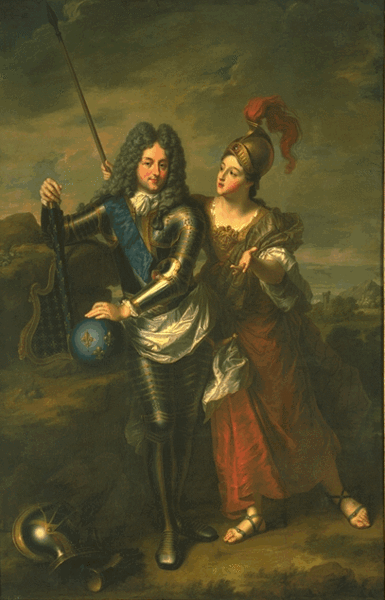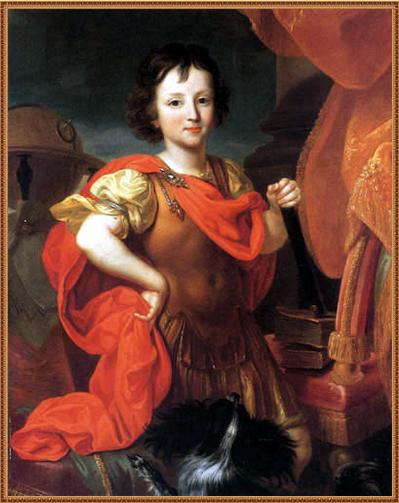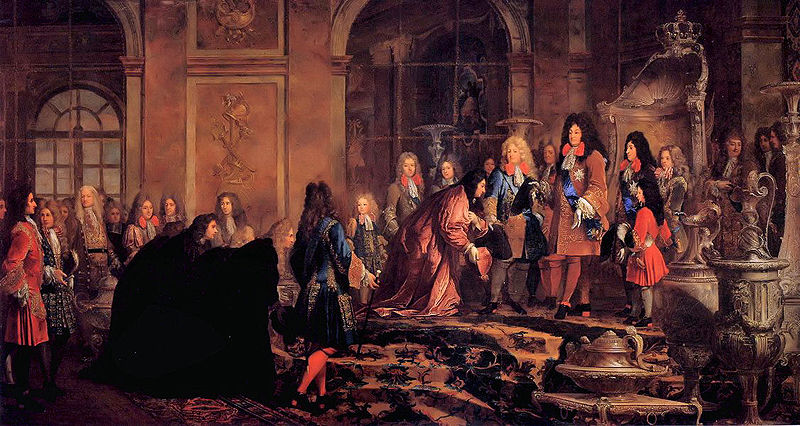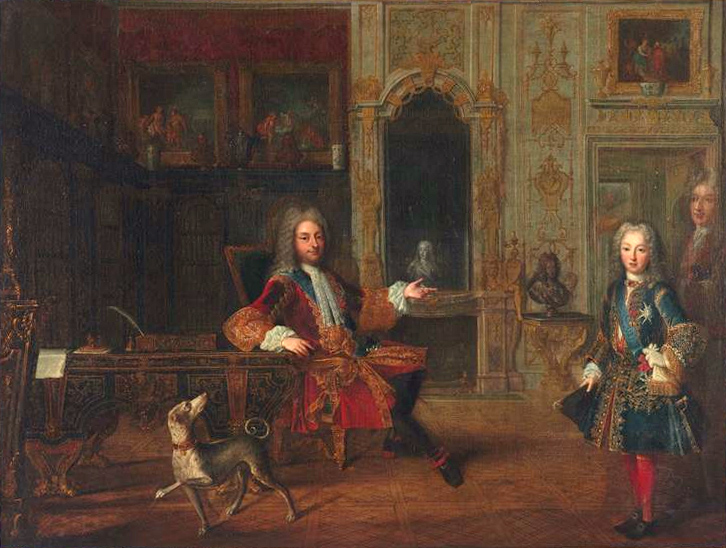<Back to Index>
- Mathematician Henry Peter Francis Swinnerton Dyer, 1927
- Writer Aino Krohn Kallas, 1878
- Duke of Orléans Philippe II d'Orléans, 1674
PAGE SPONSOR


Philippe d'Orléans (Philippe Charles; 2 August 1674 – 2 December 1723) was a member of the royal family of France and served as Regent of the Kingdom from 1715 to 1723. Born at his father's palace at Saint-Cloud, he was known from birth under the title of Duke of Chartres. His father was Louis XIV's younger brother Philippe I, Duke of Orléans, known as Monsieur; his mother was Elizabeth Charlotte of the Palatinate.
In 1692, Philippe married his first cousin, Françoise Marie de Bourbon - the youngest legitimised daughter (légitimée de France) of Philippe's uncle Louis XIV and Madame de Montespan. Named regent of France for Louis XV until Louis attained his majority in February 1723, the era of his de facto rule was known as the Regency (1715 – 1723). He died at Versailles in 1723. He is referred to historically as le Régent. In March 1661, his father married his first cousin Princess Henrietta Anne of England, known as Madame at court. The marriage was stormy; Henriette was a famed beauty, sometimes depicted as flirtatious by those at the court of Versailles. Philippe's father was a homosexual whose liaisons with men were also well known at court. Nonetheless, the marriage produced three children: Marie Louise d'Orléans, future queen of Spain, who left France in 1679 when Philippe was just five; Philippe Charles (1664 – 1666), Duke of Valois; and Anne Marie d'Orléans, born at Saint-Cloud in 1669, later queen consort of Victor Amadeus II of Sardinia (they became the maternal grandparents of Philippe's future protégé Louis XV). Madame Henriette died at Saint-Cloud in 1670 amidst rumors of having been poisoned by her husband or his long term lover, the Chevalier de Lorraine; the two would remain together till the death of the Duke of Orléans in 1701. In the following year, the Duke of Orléans wed Princess Elizabeth Charlotte of the Palatinate, only daughter of Charles I Louis, Elector Palatine and Landgravine Charlotte of Hesse-Kassel. The new Duchess of Orléans, who converted from Protestantism to Catholicism just prior to entering France, was popular at court upon her arrival in 1671 and quickly became the mother of Alexandre Louis d'Orléans in 1673, another short lived Duke of Valois. The next year the duchess gave birth to another son, Philippe Charles d'Orléans. Philippe Charles d'Orléans was born at the Château de Saint-Cloud, some ten kilometers west of Paris. As the grandson of King Louis XIII of France, Philippe was a petit-fils de France. This entitled him to the style of Royal Highness from birth, as well as the right to be seated in an armchair in the king's presence. At his birth, he was titled Duke of Chartres and was formally addressed as Monseigneur le duc de Chartres.
As the second living son of his parents, his birth was not greeted with
the enthusiasm the Duke of Valois had received in 1673. Philippe was born fourth in line to the throne, coming after Louis, Dauphin of France, his own father, and his older brother. When Philippe was born, his uncle Louis XIV was at the height of his power. In 1676, the Duke of Valois died at the Palais - Royal in
Paris, making Philippe the new heir to the House of Orléans; the
future heirs of the Duke of Orléans would be known as the Duke
of Chartres (duc de Chartres) for the next century. His distraught mother was pregnant at the time with Élisabeth Charlotte d'Orléans (1676 – 1744), future Duchess and regent of Lorraine. Élisabeth Charlotte and Philippe would always remain close. The
Duke of Chartres grew up at his father's "private" court held at
Saint - Cloud, and in Paris at the Palais - Royal, the Parisian
residence of the Orléans family until the arrestation of
Philippe
Égalité in April 1793 during the French Revolution. The Palais - Royal was frequented by, among others, Marie Anne Mancini, Duchess of Bouillon, part of Philippe's father's libertine circle. A program of how best to educate a prince was drawn up exclusively for him by Guillaume Dubois, his preceptor. Dubois
had entered Philippe's household in 1683 as his "under - preceptor".
Philippe's education was carried out by the respected instructor
Nicholas - François Parisot de Saint-Laurent until 1687. Each course of study taught the duc de Chartres the
"principles" or "elements" of a subject. Some of the best historians,
genealogists, scientists and artists in the kingdom participated in
this educational experiment, which started around 1689. For example, Philippe learned physics and mathematics from Joseph Sauveur; and from Étienne Loulié he learned musical notation, elementary musical theory, plus the basics of playing the viol and the recorder. Chartres was reared alongside Louis de Rouvroy, duc de Saint - Simon, later famous for his memoirs and defense of the rights of the peerage of France; Saint - Simon often accompanied the duke, and his wife was later a lady-in-waiting to Philippe's daughter, Louise Élisabeth d'Orléans, duchesse de Berry. Next,
collaborating to link physics and music, Sauveur and Loulié
demonstrated vibrating strings and the Galilean pendulum, and how the
mathematical principles on which these devices depend are related to
music. Finally, in 1693 the prince studied composition with Marc-Antoine Charpentier. With Charpentier's help, he composed an opera, Philomèle, performed at his residence in 1694; and in 1705 the prince wrote a second opera, Penthée, to a libretto by the marquis de La Fare. In the late 1690s Chartres studied the viol with Antoine Forqueray the elder. Meanwhile, he was studying diplomacy and riding, as preparations for a military career.
In May 1685 the duc de Chartres, then just ten years old, made his first public appearance at Versailles; the occasion was the arrival of the Doge of Genoa,
Francesco Maria Lercari Imperiale, at the French court. Chartres was
put on a stage with his uncle, cousin and father. On 2 June 1686
Chartres was invested with the Order of the Holy Spirit at Versailles; on the same day his future brother-in-law, Louis-Auguste de Bourbon, duc du Maine, also joined the order as did his cousins Louis III, prince de Condé and François Louis, Prince de Conti. His father having gained military distinction in the Battle of Cassel and during the decisive French victory against William III of England, Chartres would similarly demonstrate military prowess. Chartres had his first experience of battle at the siege of Mons in 1691, the year before his marriage. He fought with great distinction at the Battle of Steenkerque on 3 August 1692. In the same year Chartres also served at the Siege of Namur. The following year Chartres served at the Battle of Landen; he fought along side the prince de Conti, who was wounded. During a hiatus between military assignments, Chartres studied natural science. In the next century, Chartres would serve in the War of the Spanish Succession. He was next given a command in Italy (1706) and gained much credit for the Battle of Turin. Later he went to Spain and took part in the Battle of Almansa, a major step in the consolidation of Spain under the Bourbons (1707), where he achieved some important successes.
Constant wars with many of the major powers in Europe rendered a significant marriage with a foreign princess unlikely, or so Louis XIV told his brother, Monsieur, when persuading him to accept the king's legitimised daughter, Françoise Marie de Bourbon (known as Mademoiselle de Blois), as wife for Philippe. The king offered a dowry of two million livres with his daughter's hand (not to be paid until the Nine Years' War was over), as well as the Palais - Royal for
the bridegroom's parents. Upon hearing that her son had agreed to the
marriage, Philippe's mother slapped his face in full view of the court
and turned her back on the king as he bowed to her. Nonetheless, on 18
February 1692, the cousins were married. The lavish ceremony took place in the chapel of the Palace of Versailles. The service was conducted by the Cardinal de Bouillon - a member of the House of La Tour d'Auvergne.
In 1685, the Cardinal de Bouillon had refused to take part in the
marriage of the Duke of Bourbon and Françoise Marie's sister, Mademoiselle de Nantes,
and, as a result, had been sent into exile, but he was recalled for the
wedding of Françoise - Marie and the Duke of Chartres. After the
ceremony, a banquet was given in the Hall of Mirrors with all the princes and princesses of the blood royal in attendance. Guests included the exiled James II of England and his consort, Mary of Modena.
At the newlyweds' bedding ceremony later that evening, the exiled Queen
of England had the honour of handing the new Duchess of Chartres her
bed clothes. Madame de Montespan, had not been invited to the wedding of her daughter. The
young couple, mismatched from the start, never grew to like each other,
and soon the young Philippe gave his wife the nickname of Madame Lucifer. In spite of this, they had eight children. There
where contemporary rumors of an incestuous relationship between the
duke and his daughter, Marie Louise Elisabeth of Berry. These
rumors were never confirmed, although the duke reacted to them by
demonstrating affectionate behavior towards her at court. The rumors were also used by the opposition during his period as regent, and were the inspiration of libelous songs and poems. On the death of his father in June 1701, Philippe inherited the dukedoms of Orléans, Anjou, Montpensier and Nemours, as well as the princedom of Joinville. Philippe
had died at Saint-Cloud after an argument with Louis XIV at Marly about
Chartres' flaunting his pregnant mistress, Marie-Louise de Séry,
before Françoise Marie. It
has also been claimed that Philippe became so infuriated with Louis for
not paying his daughter's dowry that he suffered a paroxysm. Throughout his life Philippe had many mistresses; his wife came to prefer living quietly at Saint-Cloud, the Palais-Royal, or her house at Bagnolet. Upon the death of the prince de Condé in 1709, the rank of Premier Prince du Sang passed from the House of Condé to the House of Orléans. Philippe was thus entitled to the style of Monsieur le Prince. But the rank of petit-fils de France being higher than that of premier prince, Philippe did not change his style; nor did his son or other heirs make use of the Monsieur le Prince style which had been so long associated with the cadet branch of the Princes de Condé that the heads of the House of Orléans preferred to be known at court by their ducal title. In December 1697, the son of the Dauphin Louis de France married Princess Marie-Adélaïde of Savoy,
eldest daughter of Philippe's half sister Anne Marie. The match was
negotiated as part of the Treaty of Turin, which ended Franco-Savoyard
conflict during the Nine Years' War. The couple were the parents of two dauphins of France, Louis, Duke of Brittany, who died in 1712, and the Louis, Duke of Anjou, the future Louis XV. In 1710, his eldest (and favourite) surviving daughter Louise Élisabeth d'Orléans married her first cousin Charles, Duke of Berry;
he was a son of the Dauphin and thus outranked Philippe and his wife;
this meant that Louise Élisabeth took precedence over her
parents. The Berry couple would have no children that lived over a year. In 1711, the Dauphin died at Meudon at
the age of forty-nine and the title passed to his son, who died in
1712. Until his death in 1723, Orléans was generally considered
to be first in line to the throne, although legitimists considered that Philip V of Spain, né Duke of Anjou and fils de France, held that place, on the contention that his renunciation in 1700 was constitutionally invalid. In his will, Louis XIV appointed Orléans president of the council of regency for the young king Louis XV. Months before the death of Louis XIV, Philippe was present at the Persian embassy to Louis XIV. Mohammed Reza Beg was a high ranking official to the Persian governor of the Yerevan province (Armenia). He had been chosen by the Safavid Persian emperor Soltan Hosein for the mission and travelled with a grand entourage, as suitable to the diplomat of a mighty empire. The scene of the Persian ambassador's entry into Paris, 7 February 1715, was described by François Pidou de Saint - Olon (1646 – 1720), a nobleman who was delegated the diplomatic position of liaison officer to the Persian delegation. Louis
XIV died at Versailles on 1 September 1715, and was succeeded by his
five-year-old great-grandson, Louis XV. On 2 September, the Duke of
Orléans went to meet the parlementaires in the Grand - Chambre du Parlement in
Paris in order to have Louis XIV's will annulled and his previous right
to the regency restored. After a break that followed a much heated
session, the Parlement abrogated the recent codicil to Louis XIV's will and confirmed the Duke of Orléans as regent of France. On 30 December 1715, the regent decided to bring the young Louis XV from the château de Vincennes to the Tuileries Palace in Paris where he lived until his return to Versailles in June 1722. The regent governed from his Parisian residence, the Palais - Royal. Philippe disapproved of the hypocrisy of Louis XIV's reign and opposed censorship,
ordering the reprinting of books banned during the reign of his uncle.
Reversing his uncle's policies again, Philippe formed an alliance with
England, Austria, and the Netherlands, and fought a successful war
against Spain that established the conditions of a European peace.
During this time he opened up diplomatic channels with Russia which
resulted in a state visit by Tsar Peter the Great. He acted in plays of Molière and Racine, composed an opera, and was a gifted painter and engraver. Although an atheist, Philippe favoured Jansenism which, despite papal condemnation, was accepted by the French bishops, and he revoked Louis XIV's compliance with the bull Unigenitus. At
first, he decreased taxation and dismissed 25,000 soldiers. But the
inquisitorial measures which he had begun against the financiers led to
disturbances, notably in the province of Brittany where a rebellion known as the Pontcallec Conspiracy unfolded. He countenanced the risky operations of the banker John Law, whose bankruptcy led to a disastrous crisis in the public and private affairs of France. On 6 June 1717, under the influence of Law and the duc de Saint - Simon, the Regent persuaded the Regency Council to purchase from Thomas Pitt for £135,000 the world's then largest known diamond, a 141 carat (28.2 g) cushion brilliant, for the crown jewels of France. The diamond was known from then on as Le Régent. In
1719, Philippe lost his favourite daughter Marie Louise
Élisabeth, Dowager Duchess of Berry; she was buried at Basilica
of Saint Denis. There
existed a party of malcontents who wished to transfer the regency from
Orléans to his cousin, the young king's uncle, King Philip V of Spain. A conspiracy was formed, under the inspiration of Cardinal Alberoni,
the first minister of Spain. It was directed in France by the Prince of
Cellamare, the Spanish ambassador, with the complicity of the Duchess
of Orléans' older brother, the duc du Maine, and Anne Louise Bénédicte de Bourbon,
the latter's wife. In 1718, the Cellamare conspiracy was discovered and
its participants exiled. Two years later its aims were revived in the
Pontcallec Conspiracy, four leaders of which were executed. Guillaume Dubois, formerly tutor to the Duke of Orléans, and now his chief minister, caused war to be declared against Spain, with the support of Austria, England and the Netherlands (Quadruple Alliance). After some successes of the French marshal, the Duke of Berwick, in Spain, and of the imperial troops in Sicily, Philip V made peace with the regent (1720). From the beginning of 1721, Philip V of Spain,
and the Duke of Orléans had been negotiating the project of
three Franco - Spanish marriages in order to cement tense relations
between Spain and France. The young Louis XV of France would marry the
three year old Infanta Mariana Victoria who would thus become Queen of France; the Infante Luis would marry the fourth surviving daughter of the Philippe, Louise Élisabeth d'Orléans; and the Infante Charles would be engaged to the pretty Philippine Élisabeth d'Orléans who
was the fifth surviving daughter of Philippe. The last two occurred. In
March 1721, the Infanta Mariana Victoria arrived in Paris amid much
joy. Known as l'infante Reine (Queen - Infanta) while in France, she was placed in the care of the old Dowager Princess of Conti, Philippe's sister in law, and lived in the Tuileries Palace. In November 1721, at the age of twelve, Louise Élisabeth d'Orléans was married by proxy in Paris, Louise Élisabeth and her younger sister left for Madrid. Despite a cold reception from the Spanish royal family, especially by Elisabeth of Parma, the stepmother of her husband, she married Louis of Spain on 20 January 1722 at Lerma. Her dowry was of 4 million livres.
The last of this triple alliance was Philippine Élisabeth who
never married Charles; the marriage, though never officially carried
out was annulled; the French sent back Mariana Victoria and in
retaliation, Louise Élisabeth and Philippine Élisabeth
were sent back to France. Franco-Spanish relations only recovered in 1743 when Louis XV's son Louis de France married Mariana Victoria's sister Infanta Maria Teresa Rafaela of Spain. In
December 1722, the Regent lost his mother to whom he had always been
close; the Dowager Duchess of Orléans died at Saint - Cloud at the
age of seventy, with her son at her side, but he did not attend her
funeral service because he had been called away on official business. Philippe was greatly affected by his mother's death. On 15 June 1722, Louis XV and the court left the Tuileries Palace for the Palace of Versailles where
the young king wanted to reside. The decision had been taken by the
Duke of Orléans who, after the fall of Law's System, was feeling
the loss of his personal popularity in Paris. Philippe
took the apartments of his cousin the late Dauphin on the first floor
of the Palace; the King's apartments were above his. On 25 October of that year, the twelve year old Louis XV was anointed King of France in the cathedral of Notre - Dame de Reims. At the end of the ceremony, he threw himself in the arms of his uncle. On the majority of
the king, which was declared on 15 February 1723, the Duke stepped down
as regent. At the death of Cardinal Dubois on 10 August of that year,
the young king offered the Duke the position of prime minister, and he remained in that office until his death a few months later. The
regent died in Versailles on 2 December 1723 in the arms of his
mistress the duchesse de Falari. Louis XV mourned him greatly. The Duke
of Bourbon took on the role of Prime Minister of France. On
3 December, the Duke of Orléans' body was taken to Saint - Cloud
where funeral ceremonies began the following day. His heart was taken
to the Val de Grâce church in Paris and his body to the Basilica of Saint Denis, (about 10 km north of Paris), the necropolis of the French kings and their family. The heart of the Duke of Orléans is now at the Chapelle Royale de Dreux, the necropolis of all the members of the Orléans family, built in 1816 by his descendant Louise Marie Adélaïde de Bourbon, Duchess of Orléans, wife of Philippe Égalité. The chapel was completed as the Orléans family royal Chapel during the reign of his great-great-grandson Louis-Philippe I, King of the French.

